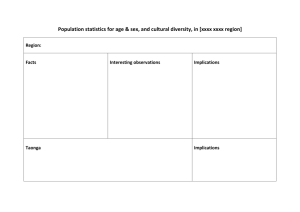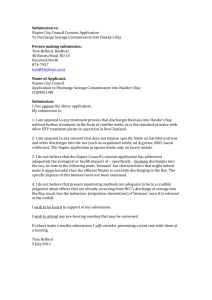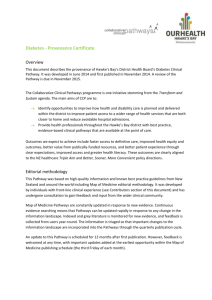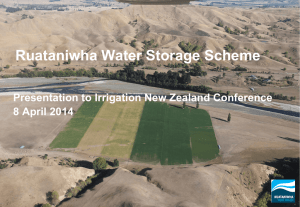Hawke`s Bay Sean Bevin Economic Solutions Report Sept 2014
advertisement
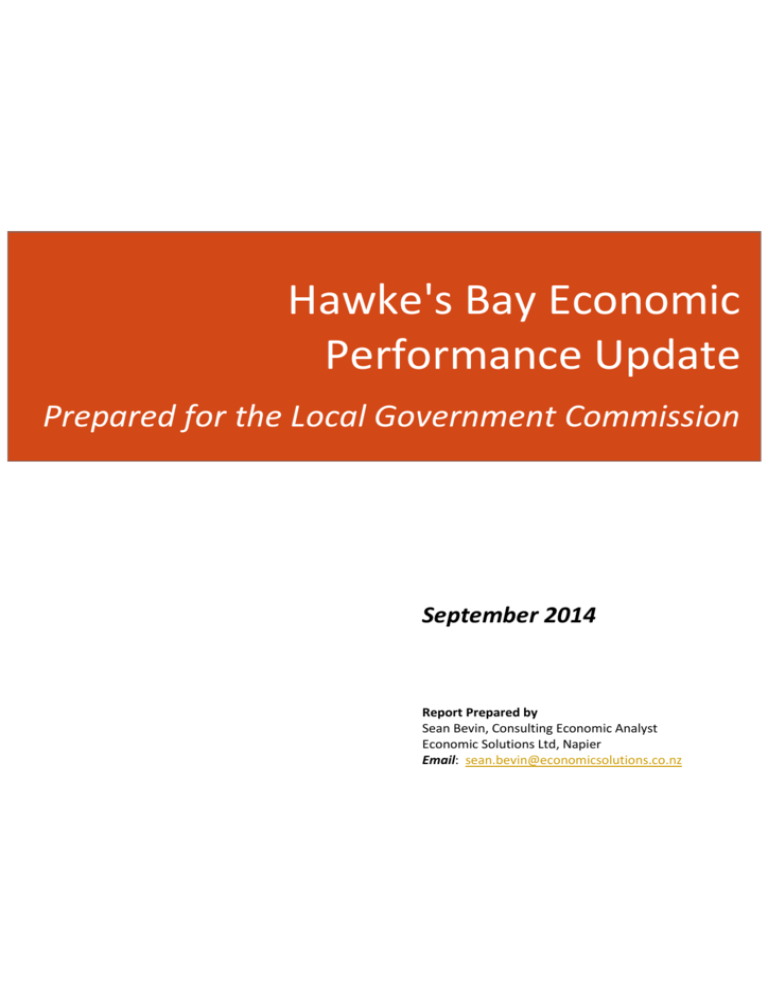
Hawke's Bay Economic Performance Update Prepared for the Local Government Commission September 2014 Report Prepared by Sean Bevin, Consulting Economic Analyst Economic Solutions Ltd, Napier Email: sean.bevin@economicsolutions.co.nz Contents Executive Summary ..............................................................................................................................i 1- Introduction .................................................................................................................... 1 2- Recent Trends ................................................................................................................. 1 3- Significant Developments ............................................................................................... 4 4- Industry Profile and Change ........................................................................................... 6 5- Napier-Hastings Economy .............................................................................................. 8 6- Economic Development Characteristics and Influences ................................................ 9 7- Key Regional Development Issues and Strategies ........................................................ 11 8- Role of Local Government ............................................................................................ 13 9- Conclusion .................................................................................................................... 14 Document1 Economic Solutions Ltd i Executive Summary This report provides an update on the recent economic performance of the Hawkes Bay economy, its key characteristics and influences, the main economic issues and challenges facing the region at the present time, policies that are required to address them effectively and the current involvement of the Local Government sector in regional economic development policy and service delivery on the ground. The report has been requested by and prepared for the purposes of the Local Government Commission which is currently investigating the structure of the Local Government sector in the Hawkes Bay region. Given that the report is primarily intended to provide further and updated background contextual regional economic information for the future deliberations of the Commission, it does not comment specifically about links that may possibly exist between the region’s economic performance and the operations of Local Government in Hawkes Bay. Rather, the report focuses on the policies that are required in Hawkes Bay to enable the region to address the key economic issues and challenges it faces in an effective and efficient manner. The policies include, as indicated in the detailed report , the application of a focused, integrated and achieveable Regional Economic Plan, which has full ‘buy in’ from all key economic development parties and actively coordinates their various activities with the objective of significantly improving and sustaining Hawkes Bay’s economic performance. It is considered that such a Plan will enable the Hawkes Bay region to take much better economic advantage of the many positive ‘infrastructural’, business, service and other developments that have occurred in the region in recent years (see Section 3 of the report) or are impending (e.g. the proposed Ruataniwha Water Storage Project and Whakatu Arterial Road) and thereby significantly lift levels of economic and employment growth. Based on the information provided in the detailed report, the key economic issues/challenges facing the Hawkes Bay region at the present time continue to include: - The significant lack of ‘economic scale’ in many respects. - A relatively small and slow-growing population and decline in the traditional working-age population. - Relatively limited and fluctuating employment opportunities and high rate of unemployment overall. - Relatively low earnings and income levels. - Generally low productivity levels and limited degree of ‘added value’ production. - Significant manufacturing sector decline. - Vulnerability of the region to ‘external’ factors adversely impacting its agricultural sector especially. - Transport deficiencies including the cost of air services to and from the region. - Tertiary education and industry research limitations. - Lack of real commercial investment opportunities in Hawke’s Bay. - Significant regional economic development planning and policy uncertainty in the region. Document1 Economic Solutions Ltd ii The report comments that the above issues should provide the main focus for future regional development strategies and policies in Hawkes Bay and the economic development work in relation to this of all relevant agencies. The report suggests that the strategies/policies include as follows: - Aggressive external promotion of the region for population, investment and new industry attraction. - Productivity enhancement initiatives across all sectors. - Policies to increase the resilience of key agricultural sectors to significant adverse climatic, economic and biosecurity events. - Strengthening of tertiary level education, training, research and technology application. - SME business growth facilitation. - Youth employment initiatives. - Further roading and transport developments in the region. The Local Government sector continues to play important roles in most of these strategies and a number of others that are implemented in Hawkes Bay. In addition, the sector has a fundamental economic development responsibility concerning the conditions within which the productive and commercial service sectors operate. This relates to, amongst other things, the broad activity of ‘environmental management’ and covers such matters as the impacts of climate change (e.g. sea level change and extreme weather events), biosecurity threats and natural hazards such as earthquakes and tsunamis. Councils have a role in responding to these factors via their planning and regulatory services, risk mitigation and providing information to the community. The effectiveness of Council policies and activities to address these issues will be enhanced significantly by greater coordination of the policies and activities. Document1 Economic Solutions Ltd 1 1- Introduction For the purposes of its current Local Government structure investigatory work in Hawke’s Bay, the Local Government Commission has requested the provision of this report generally updating the recent economic performance and situation of the Hawke’s Bay region. As part of this, the Commission is specifically interested in Hawke’s Bay’s overall economic performance versus other parts of the country; significant new business, infrastructural and other developments that have occurred or are impending in the region; the current regional economic/industry profile including the respective Napier City and Hastings District economies; main regional economic development characteristics and influences; key economic development issues facing Hawke’s Bay at the present time and strategies required to address them; and the role and work of the Local Government sector in contributing to the facilitation of economic and business development in the region. The time period adopted for this report’s analysis is the period from 2006. This incorporates the latest Census period results (2006-2013), the time period covered by Statistics NZ’s updated regional and industry GDP estimates (2007-2013) and the period since 2011 which was the end year for the regional economic analysis contained in the McGredy Winder & Co August 2012 report entitled ‘Future Prosperity of the Hawke’s Bay Region’ prepared for the Hawke’s Bay Local Government sector. It is also noted that the analysis period includes the impact of the major global financial and economic crisis from 2008/09. The main information sources for this updated economic report include Statistics New Zealand, reports from national agencies (MBIE, NZIER and BERL) on regional economic development performance in New Zealand, Hawke’s Bay local authority long-term and annual plans, local economic monitoring reports prepared by Economic Solutions Ltd for the Hawke’s Bay region and other sources. 2- Recent Trends Population The 2013 Census results indicate a total resident population for Hawke’s Bay of 151,179 or 3.6% of the national population. Over 2006-2013, the region’s population grew by 3,396 or 2.3%, compared to the New Zealand-wide change of 5.3%. Hawke’s Bay had a ranking of 12th out of the 16 regions in the country for this indicator. Over the period, the region’s share of the national population fell further; the 2001 figure was 3.8%. At the same time, the region recorded a total permanent/longterm net migration outflow of 3,780, comprising a net overseas migration outflow of 4,607 and a net internal migration inflow of 827. The largest age-group categories for the net overseas migration outflow over the latest Census period were the 15-19 and 20-24 groups. The 2013 Census results indicate that over the preceding seven years, the region’s 65+ population increased by 24.2% whilst the overall median age of the population rose from 37.5 years to 40.6 years. Document1 Economic Solutions Ltd 2 Economic Growth Figure 1 indicates the longer-term economic growth track for Hawke’s Bay since 2005. The base data for the graph is sourced from Statistics New Zealand’s updated regional/industry GDP estimates for the country for the 2007-2013 period. The Department’s nominal or current dollar terms GDP estimates have been converted to real inflation adjusted terms. As the graph shows, annual economic growth in Hawke’s Bay was relatively strong during 2005-2006. Economic decline then occurred over 2007-2008. Since then, positive growth rates have prevailed in the region other than for the 2013 March year. The regional growth rate for the March 2014 year was an estimated 2.5%. Figure 1 The Department’s estimates indicate that over 2007-2013, nominal GDP for Hawke’s Bay increased overall by 12.9%, compared to the national gain of 24.5%. The region had the second lowest rate of growth amongst the 15 measured regions in the country. Northland had the lowest growth rate at 10.2% and next after Hawke’s Bay was Manawatu-Wanganui with an 18.9% growth figure. The ANZ Bank’s quarterly index of regional economic activity growth in New Zealand, which is a different growth measure from the Department’s GDP indicator, indicates that over the same period economic activity in Hawke’s Bay grew by 3.1%, compared to 6.3% nationally. The region was ranked 12th nationally out of 14 regional areas, for this growth indicator. Northland and ManawatuWanganui had lower growth rates than Hawke’s Bay. The Bank’s growth figure for Hawke’s Bay for the latest March year was 3%, compared to 4.4% nationally. Figure 2 below indicates Statistics New Zealand GDP per capita results for 2013 for the different regions of the country. GDP per capita is a formal single measure of the overall economic standard of living in an area. The Hawke’s Bay figure ($39,035) gives it a national ranking of 12th out of the 15 listed regions. The overall national figure was $47,532; the Hawke’s Bay figure is equivalent to 82% of this level. Taranaki had the highest figure last year, at $74,341. GDP per capita in Hawke’s Bay has increased by 11.1% overall in nominal terms since 2007, thus giving the region a national ranking of 14/15 for this growth indicator. The highest regional increases were for the Taranaki, Southland, West Coast, Canterbury, Gisborne and Bay of Plenty areas, all except Canterbury being regional or ‘provincial’ areas similar to Hawke’s Bay. Document1 Economic Solutions Ltd 3 Figure 2 Labour-force The 2013 Census results indicate that total employment in the Hawke’s Bay region fell by 4,566 or 6.2% over the 2006-2013 period. The national change was +0.8%. Only one region, ManawatuWanganui (-8%), had a greater employment decline for the period. Over the year ended March 2014, Statistics New Zealand Household Labour-Force Survey (HLFS) results indicate a 1.3% fall in employment for the combined Hawke’s Bay-Gisborne area, compared to the national gain of 2.9%. Taranaki, Manawatu-Wanganui and Southland also recorded employment falls over the year. At the time of the 2013 Census, total unemployment in Hawke’s Bay stood at 5,148 or 7% of the regional labour-force, slightly less than the national figure of 7.1%. Hawke’s Bay was placed 9th out of the 16 regions in the country, for this indicator. Over the seven years prior to March 2013, unemployment in the region increased overall by 46%, compared to 44% nationally. Unemployment rose to a higher degree over the period than in Hawke’s Bay, for six other regions. Since March 2013, unemployment for the combined Hawke’s Bay-Gisborne area has fallen by 300 or 3.3% compared to -7.3% nationally; at the same time, the rate of unemployment for the former area has fallen from 8% to 7.9% and from 6.8% to 6.1% nationally. Business Performance The economic indicators evaluated in the above analysis provide a higher-level picture of the overall economic performance of the Hawke’s Bay region during the past seven years. However, they do not necessarily fully capture the more ground-level economic trends that have been occurring in the area which provide a more balanced picture of regional economic performance. These trends include the matters covered in the next section of the report. They also include an assessment of general business confidence and performance in the region. In this regard, both the Napier and Hastings Councils have been running structured formal biannual surveys of 200 businesses (covering all sectors) in their respective districts, for a number of years now. One of the survey questions concerns the current state of business trading – Figure 3 indicates the overall results for this question for the March survey this year. As shown, the leading response category is ‘good’ business trading, followed by ‘average’ and then ‘very good’ trading. Whilst this response pattern has generally prevailed during the period in which the surveys have been undertaken, prevailing regional economic conditions have impacted the proportions of businesses in each of the four response categories. Document1 Economic Solutions Ltd 4 Figure 3 3- Significant Developments There are a number of major new business/service and infrastructural developments that have occurred in recent years in the Hawke’s Bay region. In addition, there are a number of impending developments that have the potential to significantly and positively impact the regional economy over the medium to longer-term. In brief, examples of both categories include as follows: Consented new building – Statistics New Zealand figures indicate that over the period since 2010, new residential dwellings worth a combined value of $661.5 million have been consented in Hawke’s Bay. Values for other sectors include visitor accommodation ($12.2 million), commercial ($91.5 million), industrial ($92.8 million), rural ($17.3 million) and community facilities ($91.6 million). New business developments such as additional grape-growing land and winery investments in the Hastings District; further pipfruit sector investments/‘corporatisation’ and handling, storage and distribution facilities; ABB electronics company now based at the new Hawke’s Bay Airport business park, upgraded and new production/processing facilities at Pan Pac Forest Products Ltd, establishment in the Hastings CBD area of a new Kiwibank back-up head office and call centre, new packaging business in Hastings, specialist hotel/conference facility in Ahuriri/Napier, a number of substantial retail business upgrades and roll out of broadband across the region. Ruataniwha Water Storage Project – whilst this project has been consented by the Government’s Board of Inquiry, further progress on implementing the project is awaiting both the outcome of two appeals to the Board’s decision (which are expected to be heard in November 2014 and could potentially change the Board’s consent decisions) and the final level of commercial uptake of the available water. An updated consultancy report provided earlier this year to the Hawke’s Bay Regional Council indicates that the regional GDP impacts of the project are currently estimated at the construction stage (covering 12 years) $410 million, existing farming activity and farm support multiplier/flow-on impacts $136 million Document1 Economic Solutions Ltd 5 per annum at full operation of the project and potential related processing and processing support $120 million at full project operation. The Central Hawke’s Bay District is expected to benefit significantly from both the construction and operation of the project. Transport sector – since 2008, the total volume of international exports handled at the Port of Napier have increased steadily and overall by 56% (compared to 54% nationally). During the year ended June 2014, a total export tonnage of 3.1 million tonnes were handled by the Port, up almost 22% for the latest year. Total import tonnages handled by the Port have increased by 30% overall since 2008, although they slipped 11% over the latest year. Other significant developments at the Port in recent years include finalisation of a long-term infrastructural development master plan, achievement of the Port’s current status as the largest international container and break-bulk port in the central and southern North Island, the $21 million investment in the 2012/13 year in new property and plant/equipment facilities at the Port and development of the important cruise ship sector. The Port Company is anticipating a 69% increase in general cargo volumes that it will be required to handle over the next decade and a doubling of log volumes, and is budgeting in excess of $150 million for further infrastructural development over the period. Hawke’s Bay Airport Company and Roading developments – recent establishment of the new Hawke’s Bay Airport business park with ABB electronics business as the anchor tenant. The park is being developed to attract a variety of clients covering R&D, education, high tech industrial, distribution, tourism and air-side businesses. The Airport Company is planning to implement a number of other significant service upgrades and developments at the main airport, over time. The Hastings District Council’s proposed new arterial road through the major Whakatu business area, which provides an important regional freight transport link between the general Havelock North/Eastern side of Hastings and the HB Expressway/Western side of Hastings/Port of Napier, will shortly be receiving formal resource management consideration. Community and Recreational Facilities – upgraded and new facilities such as the HB Museum and Art Gallery in Napier, Marine Parade Napier recreational developments, Hastings Regional Sports Park facility extensions, and facility upgrades and service/programme initiatives at the Eastern Institute of Technology. Whilst the Hawkes Bay economy has clearly been directly impacted by the major international financial and economic downturn over the past five years or so and also the effects within New Zealand of this, nevertheless, there has been a range of significant infrastructural developments in the region which will strengthen the basis for future regional growth in the area and enable it to take better advantage of more accommodating economic conditions and policies, in association with more proactive and integrated internal regional economic initiatives. Document1 Economic Solutions Ltd 6 4- Industry Profile and Change Figure 4 below indicates, firstly, individual industry or sector shares of total industry GDP in Hawke’s Bay for the 2007 and 2013 years and, secondly, the nominal growth in industry GDP between 2007 and 2013. The base data for the graph is sourced from Statistics New Zealand’s updated regional GDP estimates released last year. The main points to note from the graph are as follows: The industries contributing most in 2013 to total regional industry GDP are, in order, commercial/business services, primary production and utility services combined, processing/manufacturing, wholesaling and retailing, health care and social assistance, and construction services. The industries which recorded noticeably increased shares of total regional industry GDP over the 2007-2013 period were primary production and utility services, transport/storage, business services, public administration, education and training, and health care and social assistance services. The manufacturing sector’s GDP share fell sharply from 22.7% down to 16.9%; the share for wholesaling/retailing fell a little whilst the construction sector’s GDP contribution was unchanged. Total industry GDP growth was highest over the period for, in order, health care and social assistance services, education and training services, public administration, visitor accommodation and food services, and primary production/utility services. Manufacturing/ processing sector GDP fell by almost 26%. Over the shorter time period of 2007-2011 (detailed Statistics New Zealand industry GDP results are only available for this period and ESL has been required to calculate estimates for years 2012/2013), Hawke’s Bay manufacturing/processing sector nominal GDP fell by 17.1%, compared to the national fall of 2.5%. Other industries where Hawke’s Bay performed significantly behind the national industry GDP growth situation were agriculture, other primary production and utility services, construction, visitor accommodation and food services, transport/storage and public administration. The region performed significantly better than the country as a whole in relation to the business services and health care/social assistance service industries. Figure 4 Document1 Economic Solutions Ltd 7 From an employment perspective, the 2013 Census results indicate that the largest employing industries in Hawke’s Bay are, in order, business services, manufacturing/processing, primary industries, health and social assistance services, retailing and education/training services. Of the above industries, those that recorded noticeable employment gains over 2006-2013 were public administration, education/training and health/social assistance services, with the latter recording a gain of 20%. Industries recording significant employment losses over the period were primary production (-11%), manufacturing (also -11%), construction (-14%) and retailing (-13%). The tourism industry is an important part of the regional economy and currently accounts for approximately 6-7% of total Hawke’s Bay GDP and employment. As shown by Figure 5, momentum in the industry was building nicely in the region when the severe global financial and economic crisis struck from around 2008. Visitor night-stays fell sharply in 2009 and further the following year. However, since then, a gradual recovery has been underway and the visitor nights tally for the latest year (YE April 2014) was 7% above the 2010 low-point. It is noted that the visitor-nights indicator comprises both domestic and international visitors staying in commercial accommodation and also those staying in private homes with relatives and friends (VFRs); the former figures are sourced from Statistics New Zealand and the latter from HB Tourism surveys. It is also noted that MBIE figures indicate that over the 2009-2013 period, total direct visitor spend in Hawke’s Bay has steadily increased and overall by 18% in nominal terms, compared to the national gain of 7%. Whilst the combined Napier-Hastings area accounted for approximately 92% of total visitor nightstays spent over the past year in surveyed commercial accommodation in Hawke’s Bay, it should further be noted that significant visitor attractions, activities and amenities are not also confined mainly to this area; there is a range of important tourism features contained in both the Central Hawkes Bay and Wairoa districts in addition to Napier/Hastings. Figure 5 Document1 Economic Solutions Ltd 8 5- Napier-Hastings Economy The 2013 Census recorded a total population figure for the combined Napier and Hastings local authority districts of 130,485, up 4,287 or 3.4% on the 2006 Census level. The combined population represents 86% of the total Hawke’s Bay population and compares with 85% in 2001 and also in 2006. Thus, there has been a small increase over time in the combined Napier-Hastings share of the total regional population. It is noted that over the 2006-2013 period, the population of Central Hawke’s Bay District fell by 1.8% down to a figure of 12,720 or 8.4% of the total regional population, whilst the population of Wairoa District fell by 7% down to a level of 7,890 or 5.6% of the total Hawke’s Bay population. The latest available population estimates from Statistics New Zealand indicate a total Year 2013 population for the main Hawke’s Bay urban area (Napier-Hastings) of 125,300 or 81% (compared with 80% in 2006) of the total regional population. Since 2006, the population of the urban area has risen by 3,400 or 2.8%, compared to the region-wide increase of 1.9%. Table 1 indicates the industry employment profile of the respective Napier City and Hastings District areas, as shown by the 2013 Census results. The significant differences between the Napier and Hastings profiles are in relation to the proportions of the workforce in primary production, manufacturing, wholesaling/retailing, accommodation/food services and transport/storage. The direct wealth-creating industries (primary production, manufacturing and construction-utility services) account for 20% of total Napier employment and 36% of total Hastings employment. The combined Napier-Hastings area accounts for 80% of total Hawke’s Bay industry employment. The area’s proportion of total regional employment is lowest for the primary industries and highest for accommodation/food services. Table 1: Total Employment March 2013 Industry Primary Industries Manufacturing Construction/Utilities Wholesaling/Retailing Accomm/Food Services Transport/Storage/Coms Business Services Public Administration Education/Training Healthcare & Welfare Arts & Recreation Other Services TOTAL Napier City 654 2,214 1,368 3,666 1,596 1,287 3,306 1,176 2,205 2,178 474 1,112 21,246 % of Total 3.1% 10.4% 6.4% 17.3% 7.5% 6.1% 15.6% 5.5% 10.4% 10.3% 2.2% 5.3% Hastings District 4,287 4,845 2,058 4,089 1,236 1,080 4,338 1,122 2,637 4,338 351 1,044 31,425 % of Total 13.6% 15.4% 6.5% 13.0% 3.9% 3.4% 13.8% 3.6% 8.4% 13.8% 1.1% 3.3% Hawke's Bay Region 8,298 8,784 4,950 8,931 3,213 3,108 8,880 2,718 5,673 7,566 951 2,523 65,595 Napier/Hastings % of Hawke's Bay 59.5% 80.4% 69.2% 86.8% 88.1% 76.2% 86.1% 84.5% 85.4% 86.1% 86.8% 85.9% The 2013 Census results indicated a total unemployment level of 1,917 or 6.9% in Napier City and 2,463 and 6.9% for Hastings District. Ministry of Social Development figures indicate a total of 4,700 people in Hawke’s Bay in receipt of the Government’s jobseeker support benefit in June this year, with the totals for Napier being 2,017 and Hastings 2,318. Document1 Economic Solutions Ltd 9 6- Economic Characteristics and Influences Effective external and internal decisions on key regional matters such as Local Government structures and processes, Central Government regional development policies and programmes in New Zealand, and Local Government and private sector involvement within regions in economic development facilitation work all require, amongst a number of things, consideration of the wider regional economic context. This includes factors such as the main economic characteristics of areas and the key influences on their economic performance. In the Hawke’s Bay context, the region’s main economic characteristics are considered to include those listed below. A number of the factors mentioned are also alluded to in previous sections of the report: A production or wealth-creating base that is heavily orientated towards the production and processing of rural commodities, a manufacturing sector geared to the servicing of the production and processing sectors, and a range of specialist commercial/business services supporting the rural sector. A rural production base that is centred around the general activities of pastoral farming, horticulture, wine, forestry, food processing and the manufacturing of textile products and forest/timber products. Resulting national rural industry specialisations in the form of sheep/beef/wool farming, pipfruit growing (approximately 60% of the national industry is located within Hawke’s Bay), certain vegetable commodities, grape-growing, forestry, meat and vegetable/fruit processing, wine-making, tanning and a range of manufactured forest product items. A major international export orientation and well-developed supply chains within these specialisations, including the role of the Port of Napier. The rural production specialisation of the region is accompanied by a significant seasonality component. This impacts its overall economic performance and moreso its labour needs, with the horticultural sector in particular requiring considerable additional labour during the February-May peak harvesting period. This is partly met by external international migrant labour sourced through Central Government’s RSE scheme. The region’s important tourism sector is also highly seasonal and adds to short-term labour demands in the area. Given Hawke’s Bay’s significant rural production base, the region’s economy is exposed considerably to external and internal changes that result in a largely fluctuating overall economic growth track over time. This, in turn, results in varying annual labour demands. The rural production and processing specialisation of the region also significantly impacts its labour-market requirements in terms of, for example, qualifications, skills and income levels. The dominance within the region’s commercial and other sectors of the SME (small medium enterprises) sector. Firms and other organisations employing under 20 staff account for 96% of all enterprises and 37% of total industry employment, in Hawke’s Bay. The sector includes Document1 Economic Solutions Ltd 10 many firms working in the rural sector (e.g. farming, contractors, rural advisers, etc) in the region. A roading and transport infrastructure that is also increasingly orientated to servicing the needs of the primary production, processing and exporting industries, in addition to the residential sector. The region’s positive physical and environmental characteristics provide the underpinning for its status as one of the key North Island domestic tourism areas and Demographic factors such as a significant Maori population and ongoing net migration outflows of young people from the region for personal development, tertiary/university, employment, travel and other reasons. The key external and internal economic influences/‘drivers’ for the Hawke’s Bay region continue to include as follows: Location – in general terms, Hawke’s Bay is ‘off the beaten track’ in respect of the main centres of population and economic activity in the North Island and in terms of the main north to south transport and communications corridor between the Auckland and Wellington areas. This situation is increasingly challenging the region’s economic performance. However, it is noted that the Port of Napier is well located in respect of New Zealand’s main east coast international shipping lane and also in respect of the related cruise ship industry. Hawke’s Bay has a relatively limited and costly air transport service. From an economic development and tourism perspective, these factors require the region to continue to invest significantly in external market promotion (‘destination marketing’) of its assets and opportunities. The ongoing economic and business performance of the region given its rural production specialisation is heavily influenced by a mix of climatic, biosecurity, international market/ commodity price and exchange rate factors. More recent examples of this include the major 2007 drought and its lingering pastoral farming impacts, other significant adverse climatic events, diseases affecting the kiwifruit and honey industries, the global financial and economic crisis (GFC) impacting from 2008 and significant Asian market growth. The Government’s economic policy responses to the GFC (e.g. Government expenditure constraints and Departmental restructuring) and its ongoing macro and micro economic policies, also continue to significantly affect regional economies such as Hawkes Bay. Availability of financial, physical, labour and infrastructural resources for business/industry growth and expansion. These resources include, for example, FDI (foreign direct investment), Government funding for primary industry research (e.g. Primary Growth Partnership), irrigation water, horticultural sector harvesting labour and migrant seasonal workers, skilled labour availability and roading/transport services. The Eastern Institute of Technology continues to provide a key tertiary level education and training service for the HB-Gisborne area; it is noted though that Central Government funding and other policies for tertiary education have had and continue to have significant effects in regional areas such as Hawke’s Bay. Document1 Economic Solutions Ltd 11 Demographic changes – for example, relative population growth in other parts of New Zealand, overall regional population size and growth, working-age population growth, net migration trends and the ageing population. Reference has already been made earlier in the report to a number of these aspects. In respect of working-age population growth, it is noted that over the 2006-2013 Census period, the traditional working-age 15-64 population fell slightly and is expected to continue to do so over the next decade. Regional impacts of Central Government budgetary and economic policy changes (the latter including the notable absence of a coherent balanced regional development policy for New Zealand). Income levels in the region relative to the larger centres. 2013 Census results indicate a median personal income level for the Hawke’s Bay region of $26,100, compared to the national figure of $28,500. The Wellington, Waikato and Auckland region figures were, respectively, $32,700, $27,900 and $29,600. The median household income levels for the above areas were Hawke’s Bay $53,200, Wellington $74,300, Waikato $59,600 and Auckland $76,500. The national figure was $63,800. There is anecdotal evidence that the relatively low income levels in Hawke’s Bay are a significant deterrent to working people wishing to relocate to the area. Future Maori Iwi and Hapu economic development initiatives in Hawke’s Bay via use of funding resources from Treaty settlements. 7- Key Regional Economic Issues and Strategies It is evident that the Hawke’s Bay economy has faced ‘difficult times’ since the mid 2000s, primarily as a result of the continuing impacts of the major international financial and economic downturn, significant intra-regional events (e.g. droughts, winter storms and frosts) adversely impacting the rural sector, and stronger growth (and competition) in other parts of the country (e.g. the Auckland region, the Auckland/Waikato/Bay of Plenty ‘economic triangle’ and the Christchurch rebuild). Some of the adverse trends occurring in Hawke’s Bay have their origins though prior to the mid 2000s. At the same time, as this report has already indicated, there have been a number of positive economic and infrastructural developments in the region over the past five years or so that should assist it in taking advantage of any significant upturn in growth that may occur over the medium-term. Recognition of the fundamental economic issues that continue to ‘dog’ the region at the present time and the active implementation of regional strategies to address them should also assist this process. On reviewing the preceding commentary in this report, the key economic development issues/challenges facing the Hawke’s Bay region at the present time are as follows: General lack of ‘economic scale’ in most respects. Population issues- relatively small population, slow growing, continued net migration losses particularly the younger age-groups, decline in the working-age population and an ageing population. Document1 Economic Solutions Ltd 12 Employment issues – fluctuating employment and employment opportunities; limited availability of skilled employment opportunities and significant orientation towards the rural, trade/hospitality and community services sectors; relatively low earnings and income levels (accompanied by significant levels of income inequality); and relatively high rates of unemployment particularly amongst the younger age-groups. Low productivity levels ‘across the board’ and an overall limited degree of ‘added value’ production. Vulnerability of the rural based regional economy to a range of external and internal factors adversely impacting its agricultural sector. Manufacturing sector decline. Transport deficiencies, for example, closure of the Napier-Gisborne railway line, use of the Marine Parade, Napier roading route for freight transport to the Port of Napier, issues with the Napier-Taupo road and cost of air services to and from the region. Tertiary education sector and industry research limitations. Lack of real commercial investment opportunities in Hawke’s Bay. Significant regional development planning and policy uncertainty in the region regarding, for example, the most appropriate policies for the region to lift its levels of economic growth, employment and incomes; what should be the respective roles in this of the region itself and of Central Government; the most appropriate roles in regional economic development facilitation for the Local Government/private/community sectors; and the balance between regional and local economic development facilitation. The range of issues listed above of themselves suggest what needs to be achieved in broad terms to significantly improve the economic performance of the Hawke’s Bay region over time. At the outset, the economic goals for the region and the strategies/actions for addressing them need to be part of an overall agreed long-term ‘regional economic plan’ for Hawke’s Bay. The Plan needs to be very focused and achievable and have full ‘buy in’ from all sectors (including local and central government) involved in the implementation of agreed actions ‘on the ground’. A suitable and wellresourced regional ‘vehicle’ will then subsequently be required to drive the implementation of the proposed Plan. The range of specific policies that are determined for driving the region’s economic performance in the future should be a matter of considerable discussion, research and consultation. In the interim, the foregoing commentary suggests that they could include the following: Aggressive promotion of the region for population, investment and new industry attraction. Productivity enhancement initiatives across all sectors. Policies to increase the resilience of key agricultural sectors to significant adverse climatic, economic and biosecurity events. Strengthening of tertiary level education, training, research and technology application. SME business growth facilitation. Youth employment initiatives. Document1 Economic Solutions Ltd 13 Further roading and transport developments in the region. 8- Role of Local Government Currently, territorial local and regional councils in Hawke’s Bay continue to be proactively involved in economic development facilitation work in their own ‘communities of interest’. It is understood that the focus of the Central Hawke’s Bay District Council’s work at the present time includes preparations for the construction stage of the RWSS (Ruataniwha Water Storage Scheme), youth employment and training initiatives, and further tourism sector development and promotion. The Napier City Council has had a longstanding involvement in local economic development facilitation work on a number of different fronts. These include ongoing infrastructural maintenance, upgrading and development in support of City economic and business needs; provision of direct funding support for key local and regional organisations (e.g. Art Deco Trust, HB Tourism and Napier Inner City Marketing); tourism sector involvement and support (e.g. operation of the Council’s own tourism ‘businesses’, amenities and Tourism Business Unit , City Marketing Programme, local Events sector support and development); development of local community and visitor product e.g. cycle trails and new Marine Parade recreational facilities; small business growth and development facilitation; Sister Cities programme; and the ongoing provision of local economic information. The economic development work of the Hastings District Council is similar to that of the Napier City Council. Specific activity sectors include new industry attraction (e.g. the new Kiwibank Call Centre), active external marketing of the District’s zoned industrial land (‘wet’, ‘dry’ and mixed industrial land portfolio), further growth of the important Whakatu business zone including advancement of the proposed new arterial road development), youth employment initiatives/Youth Futures Trust, international student attraction programme, further CBD enhancement and tourism sector support and development. In respect of the Wairoa District, the Council’s existing economic development strategy cites four important Council ‘enablers’ for economic development in the district; these are regulation, infrastructural provision, planning and community/social development policy and processes. The key opportunities for future economic development in the District are seen as revolving around rural land use and planning, tourism sector growth and business sector development. A key focus for the Council’s local economic development work is arresting the significant population decline (overall -21%) that has occurred since the mid 1990s. The Hawkes Bay Regional Council is also actively involved in regional economic development in Hawkes Bay via its ongoing environmental services delivery work and in other ways such as the work of its specialist economic development staff and significant economic projects such as the RWSS. The recommended ‘regional economic plan’ referred to in Section 7 should provide a key opportunity to focus, coordinate and integrate the future economic development work of Local Government, the private sector, Central Government and other parties in Hawkes Bay. The Local Government sector continues to play important roles in most of the strategies highlighted in Section 7 and a number of others that are implemented in Hawkes Bay. Document1 Economic Solutions Ltd 14 In addition, the sector has a fundamental economic development responsibility concerning the conditions within which the productive and commercial service sectors operate. This relates to, amongst other things, the broad activity of ‘environmental management’ and covers such matters as the impacts of climate change (e.g. sea level change and extreme weather events), biosecurity threats and natural hazards such as earthquakes and tsunamis. Councils have a role in responding to these factors via their planning and regulatory services, risk mitigation and providing information to the community. The effectiveness of Council policies and activities to address these issues will be enhanced significantly by greater coordination of their various services. 9- Conclusion The purpose of this report is to provide the Local Government Commission with an updated assessment of the recent and current performance and profile of the Hawkes Bay economy, as a further piece of background information to guide the Commission in its further deliberations on the future structure and operations of Local Government in Hawkes Bay. The analysis contained in the report indicates that the region has faced difficult economic times over the past decade or so, partly as a result of longer-term economic trends but primarily as a result of the impacts of the major international financial and economic downturn prevailing since around 2008/2009. Whilst a number of significant adverse climatic events have also impacted the rural production sector in Hawkes Bay since that time, its comparative economic performance versus other parts of the country and the nation as a whole suggests that some fundamental economic problems continue to beset the region thus preventing it from making the necessary changes that will allow it to move to a higher and more sustainable growth path with a greater number of higher quality and better paid jobs. The last decade has seen in the region a number of major infrastructural and other very positive developments and further ones are impending. It is important that the region is able to take full economic advantage of these developments. Local Government in the region, in partnership with the private sector and Central Government, has a key role to play in this process. Document1 Economic Solutions Ltd
